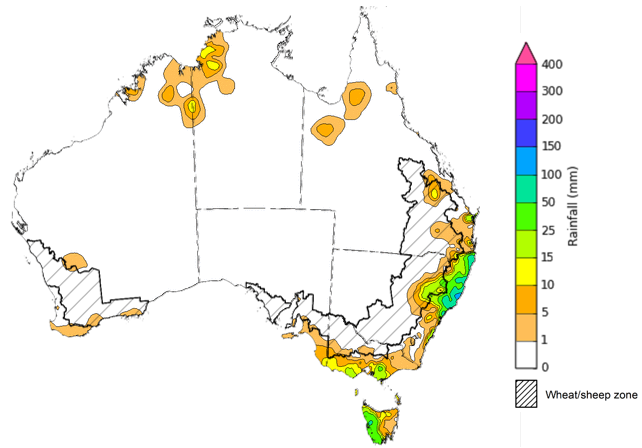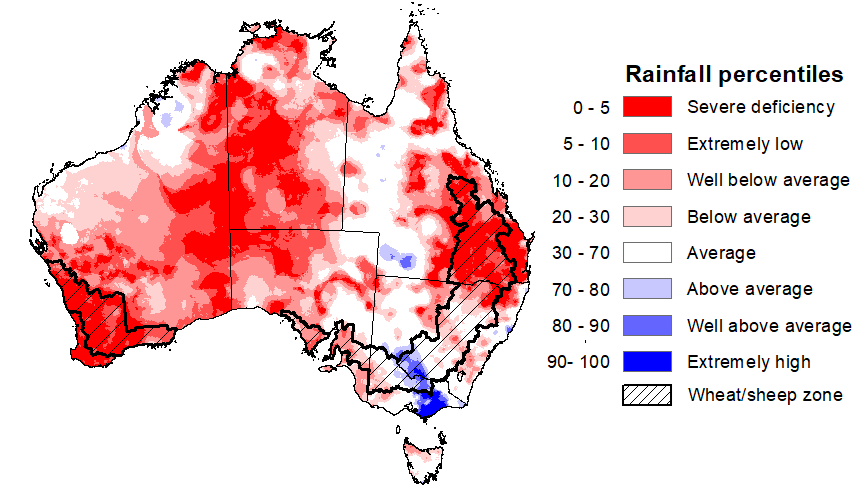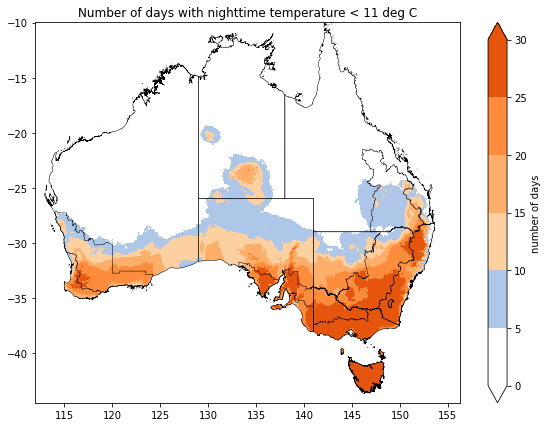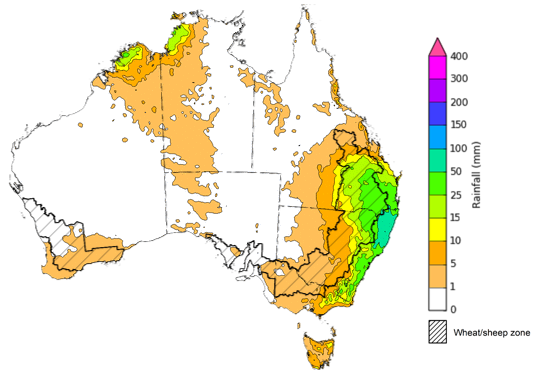Key issues
- For the week ending 1 November 2023, a high-pressure system kept much of Australia dry. A cold front brought showers in Tasmania and southern Victoria and then moved northward bringing showers to eastern parts of New South Wales.
- Across cropping regions, rainfall would have provided some relief to dwindling soil moisture levels, but it is likely that it would not have been sufficient to allow for the opportunity to plant dry land summer crops, such as, cotton and sorghum.
- The dry conditions elsewhere would have allowed for the uninterrupted harvest of early planted crops.
- Over the next 8 days, troughs will bring widespread showers and trigger storms in southern Queensland and eastern New South Wales and in country’s northwest.
- The expected rainfall would boost soil moisture levels and benefit the development of early-planted summer crops and late spring pasture production. Dry forecast conditions elsewhere will allow for a largely uninterrupted harvest of winter crops.
- Rainfall in October was severely deficient to below average for most of Australia.
- Rapid decline soil moisture levels present an elevated downside production risk for dry land summer crops and for spring/summer pasture production across much of northern and central Australia.
- October recorded many days with below 11°C (cold shock) in the southern country.
- High number of cold shock days has inhibited germination and led to poor cotton establishment and plant growth, which has prompted many producers to either replant or switch to other options like maize for cattle feed.
- Water storage levels in the Murray-Darling Basin (MDB) decreased between 26 October 2023 and 2 November 2023 by 16 gigalitres (GL). Current volume of water held in storage is 20 607 GL. This is 10 percent or 2254 GL less than at the same time last year.
- Allocation prices in the Victorian Murray below the Barmah Choke decreased from $174 on 26 October 2023 to $169 on 2 November 2023. Prices are lower in the Goulburn-Broken and regions above the Barmah choke due to the binding of the Goulburn intervalley trade limit and Barmah choke trade constraint.
Climate
For the week ending 1 November 2023, a high-pressure system brought mainly dry conditions to much of mainland Australia. A cold front brought showers in Tasmania and southern Victoria and then moved northward bringing showers to eastern parts of New South Wales.
Across cropping regions, rainfall totals of up to 25 millimetres were recorded in far north-eastern parts of New South Wales and up to 15 millimetres in an isolated part of northern Queensland. While this rainfall would have provided some relief to dwindling soil moisture levels it is likely that it would not have been sufficient to allow for the opportunity to plant dry land summer crops, such as, cotton and sorghum. Little to no rainfall was recorded across remaining cropping areas. The dry conditions across most cropping regions would have allowed for the uninterrupted harvest of early planted winter crops.
Rainfall for the week ending 1 November 2023
Issued: 1/11/2023
Note: The rainfall analyses and associated maps utilise data contained in the Bureau of Meteorology climate database, the Australian Data Archive for Meteorology (ADAM). The analyses are initially produced automatically from real-time data with limited quality control. They are intended to provide a general overview of rainfall across Australia as quickly as possible after the observations are received. For further information go to http://www.bom.gov.au/climate/rainfall/
October 2023 was the driest October since 2002 with total rainfall 65% below long-term average, nationally. Rainfall was severely deficient to below average for most of Australia, with exceptions being central and eastern Victoria extending to adjacent parts of New South Wales and isolated part in southern Queensland and northern Western Australia where rainfall was above average.
In cropping regions, October rainfall was highly variable ranging from extremely low in Queensland and Westen Australia to well above average in parts of New South Wales and Victoria. While the lack of rainfall would have allowed for an uninterrupted harvest of winter crops, a rapid decline soil moisture levels present an elevated downside production risk for dry land summer crops and for spring/summer pasture production across much of northern and central Australia.
Rainfall percentiles for October 2023
Rainfall and cooler than normal temperature during October have aided winter crop prospects across the far southeast of the country. The boost in soil moisture levels and cool temperatures stabilised yield potential in winter cereal and is likely to benefit oil content in canola.
Meanwhile, these cooler than normal temperatures, particularly night-time temperatures, has not been all good news for irrigated summer crop producers. With cotton planting well underway across southern New South Wales since early September, those producers who were able to plant early their crops are tracking well, with germination occurring under ideal warm conditions in September.
However, many producers didn’t plant until after the widespread rainfall in early October. This rainfall brought a significant change in weather patterns and temperatures. Through October there have been many nights (in excess of 20 in some areas) where the night-time temperature dropped below 11°C, across major cotton growing regions in southern New South Wales. Night-time temperatures this low are typically referred to as cold-shock days. This high number of cold-shock days has inhibited germination and led to poor cotton establishment and plant growth, which has prompted many producers to either replant or switch to other options like maize for cattle feed.
Number of cold shock (minimum temperature < 11°C) days in October 2023
Over the 8 days to 9 November 2023, troughs are expected to bring widespread showers and trigger storms in southern Queensland and eastern New South Wales and in country’s northwest.
Across cropping regions, rainfall totals up to 50 millimetres are forecast for Queensland and northern New South Wales, while little to no rainfall is expected elsewhere. This expected rainfall would boost soil moisture levels and benefit the development of early-planted summer crops and late spring pasture production. Meanwhile the dry forecast conditions elsewhere will allow for a largely uninterrupted harvest of winter crops.
Total forecast rainfall for the period 2 November 2023 to 9 November 2023
Issued 1/11/2023
Note: This rainfall forecast is produced from computer models. As the model outputs are not altered by weather forecasters, it is important to check local forecasts and warnings issued by the Bureau of Meteorology.
Water
Water storages, water markets and water allocations - current week
The Tableau dashboard may not meet accessibility requirements. For information about the contents of these dashboards contact ABARES.
Commodities
Information on weekly price changes in agricultural commodities is now available at the Weekly commodity price update.




